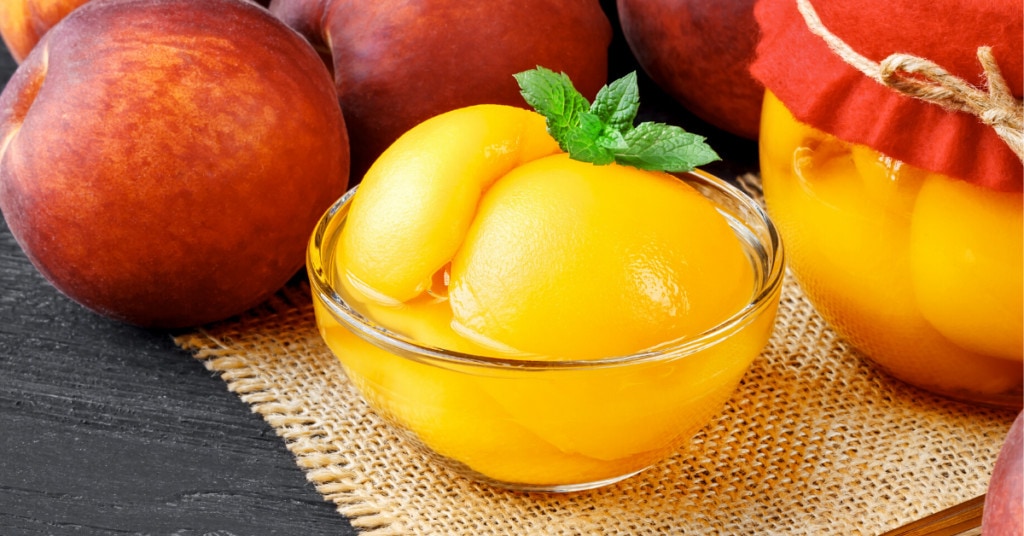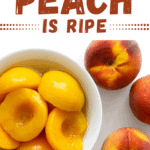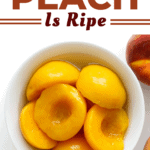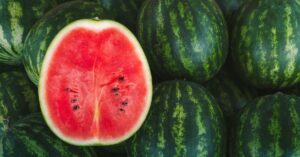From the color to the smell, knowing how to tell if a peach is ripe is super easy.
But remember, peaches will continue to ripen after picking. So if you don’t want to eat it right away, go for slightly underripe fruits.

One of the best things about summer is that all the best fruits are finally back in season, including my favorite… Peaches!
I never let a summer (especially the Fourth of July) go by without enjoying a delectable peachy dessert.
Peach cobbler, upside-down cake, or peaches and cream pie are some of my faves.
It’s just so much fun getting creative in the kitchen with this sweet, juicy, tangy fruit.
Plus, I can get them fresh which makes these fruity desserts taste even better.
If you find yourself in the kitchen ready to make some peach treats for the family or even just snacking on a perfectly golden peach, here’s how you can tell if it’s ripe and ready to eat!
How to Tell If a Peach is Ripe
There are several ways to tell if your peaches are perfectly ripe or if you have to be a little patient and wait for them to be ready.
Peaches, like mangoes or bananas, are known as a climacteric fruit, or fruits that continue to ripen after they’ve been picked or harvested. It’s important to keep this in mind when you buy them at the store so you can plan ahead.

Color and Appearance
The first thing you’ll notice about a peach is its color. Normally they are golden yellow and will have a few rosy red spots. Some might think that this color gradient indicates whether it’s ripe or not, but the red parts of a peach are actually just the parts where it is most exposed to sunlight and does not indicate ripeness.
The best way to check for the color of a peach is to look at the skin just around the stems as this is the part that is least likely to be exposed to light.
If it is light yellow in color or has some tinges of green, this means that the peach is not yet ripe.
If you want a fully ripe peach that is juicy and ready to eat, pick one that is a deeper, golden yellow just around the stem.
You also don’t want an overripe peach so avoid ones that have dark spots or bruises. You also don’t want peaches to be wrinkly because this means that they’ve been chilled for too long and are definitely overripe.
Smell
Another way to identify ripe peaches is to use your sense of smell!
An unripe peach will have a very subtle, barely-there scent. Some will even have no scent at all.
It’s best to skip these odorless peaches if you’re really excited for that cobbler!
A perfectly ripe peach will have a sweet, floral scent even from a few inches away.
This is what you’re looking for because it’s definitely going to taste as good as it smells!
Touch
Okay, listen close because this is the best way to check for ripeness: It’s all about how hard or soft a peach is.
Baseball Peaches = Underripe
The first thing to remember is that a peach as hard as a baseball is no good.
If they are this tough, it means they were picked much too early and might never fully ripen.
You don’t want that!
Tennis Ball Peaches = Not Quite Ripe
If you want something not fully ripe but almost ripe, you want a peach with the same hardness as a tennis ball.
It has a little give, but is tough enough to bounce back.
As mentioned, peaches continue to ripen even after they’re picked. So you can leave tennis ball peaches on the counter for a few days until they’re ripe.
Soft Peaches = Ripe
And the best, juiciest, sweetest peaches? They’ll be a little softer, and you’ll have to be more gentle.
Take the peach in your hand and gently give it a small squeeze with your thumb.
If it’s hard enough to have some resistance but soft enough to leave an indentation, this means that the peach is ready and should be used or eaten within the day.
Mushy Peaches = Overripe
Of course, you don’t want an overripe peach, right?
If they are too soft, feel mushy, and bruise easily even when held gently, this means the peach is past its prime.
The Perfect Peach
If you just can’t wait to take a bite of that fruity, floral goodness, remember that a perfectly ripe peach will be golden in color around the stem with no tinges of green anywhere.
It will smell sweet and fragrant. And lastly, it will be gentle enough to leave a small dent but not a bruise when gently squeezed.
So if you’re at the grocery or the farmer’s market, you’ll be able to identify peaches that are juicy, ripe, and ready to eat!

How to Store Peaches
Because peaches continue to ripen even after they are picked, how you store them is very important. This will affect how quickly or slowly they reach full, perfect, ripeness – just in time for when you want to eat them.
Keep these tips in mind when storing your peaches.
- If your peaches are unripe, leave them at room temperature in your kitchen, ideally near a window so they get a little bit of sunlight but not too much!
- It is best if the peaches don’t touch each other as this will cause them to bruise or ripen too quickly. And as much as possible, avoid touching them with your hands too!
- If you’re getting excited about eating them and want them ripe as soon as possible, place them in a paper bag. Then add a ripe banana or apple to the bag! Your peaches will be ripe and ready in 1 to 2 days. But be sure to check them every 24 hours.
If you want to slow down the ripening process, simply place your peaches in the refrigerator.
Keep in mind that you can only keep almost-ripe peaches up to a week in the fridge. If it’s been seven days, you definitely have to use them soon because you don’t want wrinkly or mealy peaches. In that case, get ready to make a peach smoothie!
Peach Recipes You Have To Try
Peach Cobbler
Peach Pie
Fruit Salad With Peach Pie Filling
Peach Crisp












